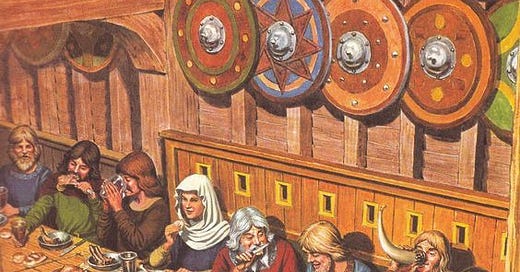Two days ago I woke to the frost’s miniature kingdoms perched all atop the roses and grass in the garden, and the previous day’s footprints in the mud lifted by glassy filaments of ice underneath. It was the first day the frost came to the Borders and stayed through that day and into the next, so I had to conclude that winter, with all its enchantment, is truly here.
I neglected to remind subscribers to ask questions for this month’s Q&A episode, which resulted in no questions, so I thought it might be nice to share something special for subscribers in its stead. To that point, please submit your questions for the next Q&A post here, and I’ll be happy to share my thoughts with you via a special audio episode next month!
Today I’m sharing an excerpt from a book of winter folklore I’ll be releasing in 2025 with the excellent Cascadian publisher Hyldyr.1 The book is still in an early draft, so feel free to share your thoughts in the comments if there is something you would love to see included.
The audio version of this post is included below for subscribers!
Winter
Under the frosty moons of winter our human communities are drawn closer to the hearth and one another like the narrowing drawstring of a purse, and our traditional ways are yearly given centre stage. The weather of this season in northern latitudes can be so oppressive that many creatures opt out entirely: some enter the coma-like sleep of hibernation and others depart via ancient migration paths. By contrast, humanity’s intellectual gifts of song, story, craft, ceremony and cookery shine as we find our summertime range limited by the chill wind and weather. Oral tradition thrives in the winter months, with its indoor days of crafting and cultural transmission. It makes some intuitive sense to say that winter’s cold weather is a cultural preservative.
Winter is as old as Earth’s home in this solar system, and in northern European cultures, many ancient ideas cling to this season still. The English word “winter” might share its Proto-Indo-European root with the words “wet” and “water,” though the word is so old its earlier forms are sometimes taken by linguists to mean simply, “winter.” The northern hemisphere’s Celtic and Germanic cultures share a prehistoric definition of winter as spanning half of the year, from the first full moon after the autumn equinox to the first full moon after the spring equinox, modern-day November through April. Though spring and autumn became a part of European calendars with Roman and Norman influence, this old two-season calendar left a deep mark in the collective memory of northern Europe, a mark that shapes the ritual year to this day.
There is good reason to believe that the start and end of old Celtic and Germanic winter were determined by the seasonal migrations of animal herders. We can thank our cattle, sheep and goat-herding ancestors for providing the grounds for the many ritual traditions that still remain around Hallowe’en and May Day, two of the richest moments in the year for folk tradition in northern Europe. These two holidays function as spiritually potent thresholds between two distinct worlds, bright, abundant summer, with its wide-ranging vistas where animals can graze at will, and dark, hungry winter, with its grey and limited horizon when humankind are called back to the village, and livestock to the byre. Cormac’s Glossary, a 10th century Irish dictionary, noted that in the time of the druids, these priests drove cattle between two bonfires at Beltane, now May 1st, as a ritual purification and blessing before they were led out to pasture for the summer months. We can assume that a similar ritual took place at Samhain, now October 31st. Gaelic folk tradition still maintains that the veil between worlds is thin at Samhain and Beltane, and Halloween traditions of ghosts, horrors and supernatural beings have carried this understanding forward even to the distant shores of the world.
Keep reading with a 7-day free trial
Subscribe to Danica Boyce at Enthusiastica to keep reading this post and get 7 days of free access to the full post archives.




